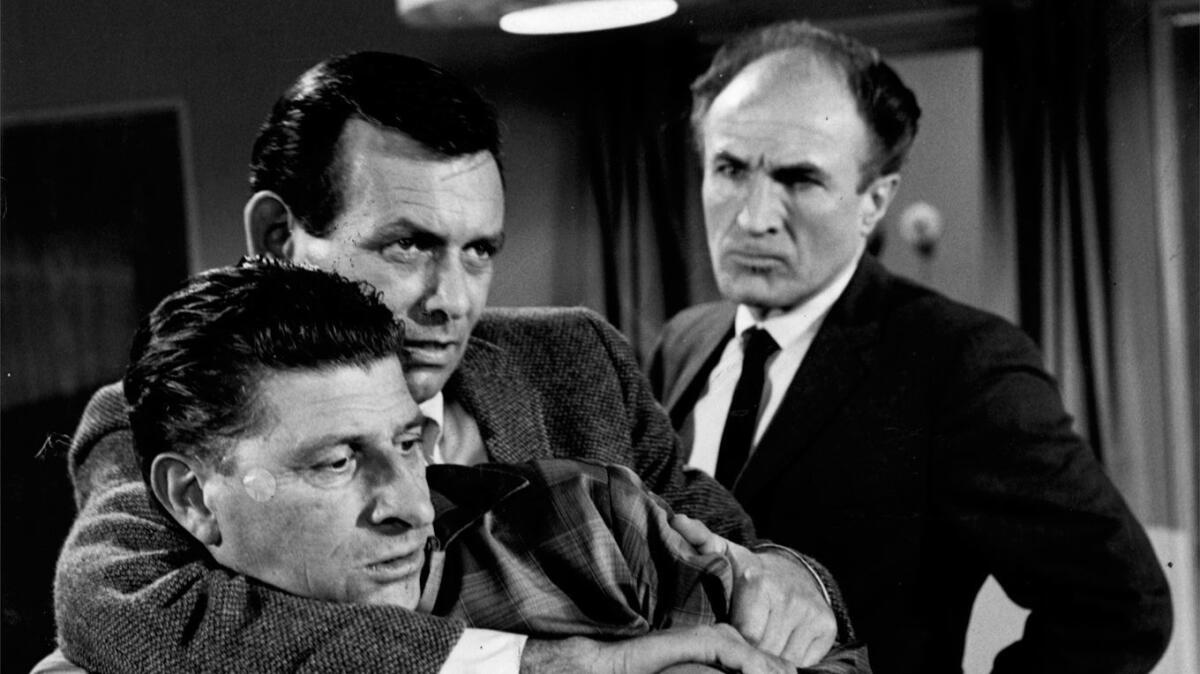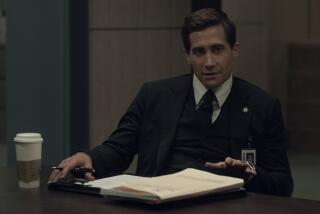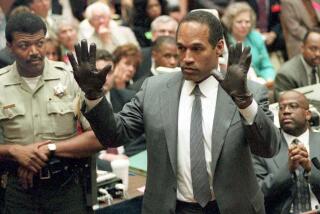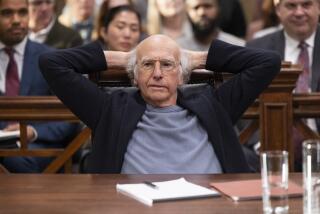50 years before peak TV, ‘The Fugitive’ set a precedent for big series finales

- Share via
Fifty years ago, “The Fugitive” stopped running. The end of the pursuit also gave TV its first lesson in figuring out how to say goodbye.
The ABC series starring David Janssen as Richard Kimble, the physician wrongly convicted of killing his wife, was one of the best-loved series of the 1960s and the basis of the hit 1993 theatrical feature featuring Harrison Ford, as well as a short-lived CBS remake in 2000 starring Tim Daly and Mykelti Williamson.
Before the finale of “The Fugitive,” watched by a then-record audience of 78 million viewers on Aug. 29, 1967, there had never been a big planned send-off to a popular network TV show that provided a massive communal experience for fans.
And therein lies a tale.
For four seasons, “The Fugitive” found the hunted Kimble fleeing to a different city or town each week, adopting aliases and taking on menial jobs while eluding Lt. Philip Gerard (Barry Morse), the obsessed detective whom Kimble escaped en route to his execution. Kimble was also hell-bent on proving that Fred Johnson (Bill Raisch), the mysterious one-armed man he saw leaving his home on the night his wife, Helen, was murdered, was the culprit.
The role of Kimble made Janssen one of TV’s biggest stars. He was on screen nearly every minute, often in fight scenes and frequently on the run. Even though the series was one of ABC’s most popular shows — scoring an outstanding drama series Emmy in 1966 — the actor made it known in the fourth season that he had enough of the drama’s grueling production schedule and desired a film career.
Once ABC announced in the winter of 1967 that “The Fugitive” was in its final season, Leonard Goldberg, a network programming executive at the time, remembered how friends would ask him how Kimble’s journey would wrap up.
“I said, ‘Well, it’s going to end — it will be over like all other television shows,’” recalled Goldberg, currently the executive producer of “Blue Bloods” on CBS. “We hadn’t planned on ending it.”
Ed Robertson, author of “The Fugitive Recaptured,” said the show’s creator Roy Huggins envisioned a conclusion to the cat-and-mouse triangle of Kimble, Gerard and Johnson. But Huggins was not involved in the show beyond selling the idea. There was no road map for resolution. Other long-running series of the time simply went away quietly without tying up loose ends.
Even with its recurring stories involving Gerard, the one-armed man and Kimble’s family, “The Fugitive” was not a serialized drama. The formula was primarily self-contained stories. Continuity was a low priority — many actors cast as guest stars appeared many times in different roles.
Goldberg remembers hearing from his ABC bosses that the audience had no interest in how Kimble’s personal story ended. But he argued that fans had become emotionally involved with the overarching plot lines. Young viewers in the turbulent 1960s were attracted to the anti-establishment undertones in Kimble’s continued evasion of law enforcement — a device that one ABC executive had believed was “un-American” when the show was first pitched.
Said Goldberg, “ ‘I said, ‘Our viewers invested four years with Richard Kimble. He’s become real to them. And they want to know what happens to him.’ ”
Complicating the situation were business concerns over how a resolution to the story would damage the market for repeats and syndication.
Quinn Martin, the producer of the series, was already seeing $500,000 a year go away with its cancellation. He was counting on a bounty from the sale of episodes to local TV stations. “The Fugitive,” which aired in 69 countries, was also ABC’s most popular and lucrative property overseas. (Janssen said he was frequently quizzed about Kimble wherever he went on vacation in Europe.)
Martin ultimately agreed that fans deserved a finale, and a script was quickly written. But the network, wanting to make sure ratings for repeats would hold up over the summer, waited to air the two-part story, titled “The Judgment,” in the last two weeks of August. Goldberg also believed the farewell would help promote ABC’s upcoming fall lineup.
In the episodes, Gerard learns of the arrest of Johnson for an assault he committed in a Los Angeles topless bar. A news wire service story about the crime is planted, luring the on-the-lam Kimble to police headquarters where Johnson is being held (much of the episode’s location work was filmed in downtown L.A.). But a witness to Helen Kimble’s murder — a panicked war hero neighbor too ashamed to come forward after failing to help her — secretly posts bail for Johnson.
That development eventually leads to a chase back to the scene of the crime in Kimble’s Indiana hometown, and the good doctor is eventually exonerated following a dramatic Western-style showdown filmed in the former Pacific Park at the Santa Monica Pier.
Actress Diane Baker still remembers her role as a young paralegal who discovers Gerard’s ruse and saves Kimble from turning himself in before the new witness can be identified.
“I loved the idea of me getting to come into a series at the end and that it would be so special,” said Baker, who is currently executive director of the acting school at San Francisco’s Academy of Art University. “It was always a joy to work with an instinctive actor, and that’s what David was.”
Baker was out of the country when Part 2 of “The Judgment” aired. But she learned quickly of its impact while in Madrid for the filming of “Krakatoa: East of Java” with Maximilian Schell. Spanish journalists besieged her at the location shouting, “El fugitivo! El fugitivo!”
“The day the running stopped,” as the show’s omniscient narrator William Conrad described it, had become world news.
Part 2 of “The Judgment” was seen in 72% of the homes using television on the night it aired against scant competition on CBS and NBC. The audience size remained a Nielsen record until Nov. 1980, when it was topped by the “Who Shot J.R.?” episode of “Dallas.”
In the pre-Internet era of 1967, there was no online obsessing or major spoilers revealed about the ending. Janssen was known for joking that “The Fugitive” would conclude with Kimble relaxing on a desert island and removing a prosthetic arm, showing that he had murdered Helen. (“I killed her, Joey — she talked too much,” Janssen cracked to ABC late-night talk show host Joey Bishop.)
The actual reveal was kept under wraps under Martin’s orders. ABC did not provide advance screening of the finale for TV critics.
“The media didn’t understand how important it was to the viewers,” said Goldberg. “Had they realized it was going to be this enormous of an event, I think they would have done a better job of finding out what the ending was going to be.”
Some journalists were not impressed.
“Hardly worth waiting four years for,” Variety wrote in its critique. New York Post TV columnist Bob Williams quaintly described ABC as “greedy” for holding the episodes until the summer repeats had finished. But the staggering Nielsen ratings validated the network’s decision.
Fears that the climax would doom the aftermarket for “The Fugitive” proved unrealized. Reruns of the series remained popular through the decades that followed on such stations as KDOC in Los Angeles and A&E, which aired the series in the 1990s. The series currently runs on the pop culture history network Decades, which is airing both parts of “The Judgment” on Tuesday at 7 a.m. and midnight (Pacific).
The popularity of “The Judgment” meant that hit TV shows were no longer destined to fade away quietly. Series finales became pop culture celebrations. The final episode of the beloved sitcom “MASH” was watched by 106 million viewers on Feb. 28, 1983, a record that stood for 27 years, until Super Bowl XLIV surpassed it in 2010. NBC turned its send-offs of “Cheers,” “Seinfeld” and “Friends” into two-hour events, scoring massive audiences.
Like everything in the current TV landscape where viewers have myriad program choices, series finales are not as big as they used to be.
“The ‘Must See TV’ comedies were still extremely popular when they ended,” said Preston Beckman, an NBC executive in the 1990s who is now a consultant. “What’s happened over the last few years is that networks hold on to shows two or three years longer than they should.”
But when ongoing TV sagas such as “The Walking Dead” and “Game of Thrones” are finally resolved, fans in large numbers will be seeking satisfaction and debates will rage (Cue up the ongoing furor over the conclusion of “Lost.”)
As “The Fugitive” first proved 50 years ago, people care.
Twitter: @SteveBattaglio
More to Read
Inside the business of entertainment
The Wide Shot brings you news, analysis and insights on everything from streaming wars to production — and what it all means for the future.
You may occasionally receive promotional content from the Los Angeles Times.











